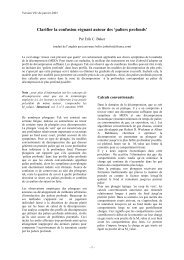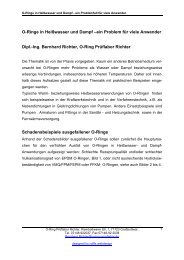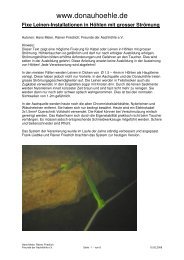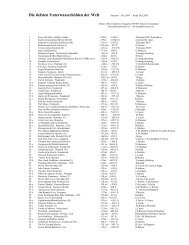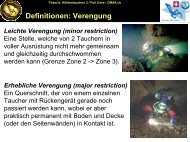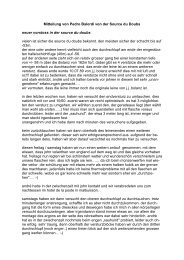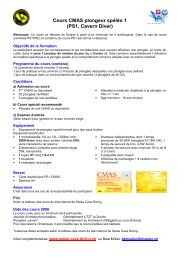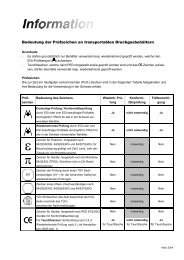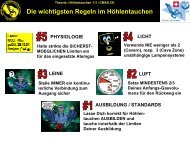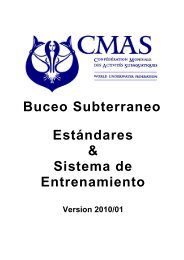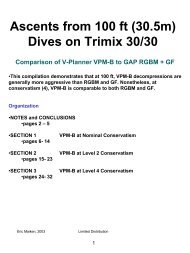- Page 2 and 3: DAVID RHEA PHOTO/GUE.COM Technical
- Page 4 and 5: Technical Diving Conference Summary
- Page 6 and 7: Technical Diving Conference Summary
- Page 8 and 9: Editors: Richard D. Vann, B.A., B.S
- Page 10 and 11: Technical Diving Conference Summary
- Page 12 and 13: Physiology Workshop Chairman’s Su
- Page 14 and 15: Physiology Workshop Respiratory Iss
- Page 16 and 17: Physiology Workshop Respiratory Iss
- Page 18 and 19: Physiology Workshop Respiratory Iss
- Page 20 and 21: Physiology Workshop Respiratory Iss
- Page 22 and 23: Physiology Workshop Respiratory Iss
- Page 24 and 25: Physiology Workshop Respiratory Iss
- Page 28 and 29: Physiology Workshop Respiratory Iss
- Page 30 and 31: Physiology Workshop Respiratory Iss
- Page 32 and 33: Physiology Workshop Respiratory Iss
- Page 34 and 35: Physiology Workshop Respiratory Iss
- Page 36 and 37: Physiology Workshop Respiratory Iss
- Page 38 and 39: Physiology Workshop Respiratory Iss
- Page 40 and 41: Physiology Workshop Central Nervous
- Page 42 and 43: Physiology Workshop Central Nervous
- Page 44 and 45: Physiology Workshop Central Nervous
- Page 46 and 47: Physiology Workshop Central Nervous
- Page 48 and 49: Physiology Workshop Central Nervous
- Page 50 and 51: Physiology Workshop Central Nervous
- Page 52 and 53: Physiology Workshop Central Nervous
- Page 54 and 55: Physiology Workshop Central Nervous
- Page 56 and 57: Physiology Workshop Central Nervous
- Page 58 and 59: Physiology Workshop Central Nervous
- Page 60 and 61: Physiology Workshop Central Nervous
- Page 62 and 63: Physiology Workshop Central Nervous
- Page 64 and 65: Physiology Workshop Central Nervous
- Page 66 and 67: Physiology Workshop Central Nervous
- Page 68 and 69: Physiology Workshop Nitrogen Narcos
- Page 70 and 71: Physiology Workshop Nitrogen Narcos
- Page 72 and 73: Physiology Workshop Nitrogen Narcos
- Page 74 and 75: Physiology Workshop Nitrogen Narcos
- Page 76 and 77:
Physiology Workshop Nitrogen Narcos
- Page 78 and 79:
Physiology Workshop Nitrogen Narcos
- Page 80 and 81:
Physiology Workshop Nitrogen Narcos
- Page 82 and 83:
Physiology Workshop Nitrogen Narcos
- Page 84 and 85:
Physiology Workshop Nitrogen Narcos
- Page 86 and 87:
Physiology Workshop Nitrogen Narcos
- Page 88 and 89:
Physiology Workshop Nitrogen Narcos
- Page 90 and 91:
Physiology Workshop Nitrogen Narcos
- Page 92 and 93:
Physiology Workshop Nitrogen Narcos
- Page 94 and 95:
Physiology Workshop Nitrogen Narcos
- Page 96 and 97:
Physiology Workshop Nitrogen Narcos
- Page 98 and 99:
Physiology Workshop Nitrogen Narcos
- Page 100 and 101:
Physiology Workshop Thermal Concern
- Page 102 and 103:
Physiology Workshop Thermal Concern
- Page 104 and 105:
Physiology Workshop Thermal Concern
- Page 106 and 107:
Physiology Workshop Thermal Concern
- Page 108 and 109:
Physiology Workshop Thermal Concern
- Page 110 and 111:
Physiology Workshop Nitrogen Narcos
- Page 112 and 113:
Physiology Workshop Pathophysiology
- Page 114 and 115:
Physiology Workshop Pathophysiology
- Page 116 and 117:
Physiology Workshop Pathophysiology
- Page 118 and 119:
Physiology Workshop Pathophysiology
- Page 120 and 121:
Decompression Workshop Risk Factors
- Page 122 and 123:
Decompression Workshop Risk Factors
- Page 124 and 125:
Decompression Workshop Risk Factors
- Page 126 and 127:
Decompression Workshop Risk Factors
- Page 128 and 129:
Decompression Workshop Risk Factors
- Page 130 and 131:
Decompression Workshop Risk Factors
- Page 132 and 133:
Decompression Workshop Risk Factors
- Page 134 and 135:
Decompression Workshop Risk Factors
- Page 136 and 137:
Decompression Workshop Risk Factors
- Page 138 and 139:
Decompression Workshop Risk Factors
- Page 140 and 141:
Decompression Workshop Deep Stops a
- Page 142 and 143:
Decompression Workshop Deep Stops a
- Page 144 and 145:
Decompression Workshop Deep Stops a
- Page 146 and 147:
Decompression Workshop Deep Stops a
- Page 148 and 149:
Decompression Workshop Deep Stops a
- Page 150 and 151:
Decompression Workshop Deep Stops a
- Page 152 and 153:
Decompression Workshop Deep Stops a
- Page 154 and 155:
Decompression Workshop Deep Stops a
- Page 156 and 157:
Decompression Workshop Deep Stops a
- Page 158 and 159:
Decompression Workshop Deep Stops a
- Page 160 and 161:
Decompression Workshop Assessing th
- Page 162 and 163:
Decompression Workshop Assessing th
- Page 164 and 165:
Decompression Workshop Assessing th
- Page 166 and 167:
Decompression Workshop Assessing th
- Page 168 and 169:
Decompression Workshop Assessing th
- Page 170 and 171:
Decompression Workshop Assessing th
- Page 172 and 173:
Decompression Workshop Assessing th
- Page 174 and 175:
Decompression Workshop Assessing th
- Page 176 and 177:
Decompression Workshop Assessing th
- Page 178 and 179:
Decompression Workshop Assessing th
- Page 180 and 181:
Therapy for Decompresson Illness Th
- Page 182 and 183:
Therapy for Decompresson Illness th
- Page 184 and 185:
Therapy for Decompresson Illness ad
- Page 186 and 187:
Therapy for Decompresson Illness co
- Page 188 and 189:
Therapy for Decompresson Illness 5
- Page 190 and 191:
Therapy for Decompresson Illness 6.
- Page 192 and 193:
Therapy for Decompresson Illness co
- Page 194 and 195:
Therapy for Decompresson Illness tr
- Page 196 and 197:
Therapy for Decompresson Illness Na
- Page 198 and 199:
Therapy for Decompresson Illness Ed
- Page 200 and 201:
Therapy for Decompresson Illness Me
- Page 202 and 203:
Therapy for Decompresson Illness be
- Page 204 and 205:
Workshop Rebreather Workshop: Chair
- Page 206 and 207:
Testing Divers’ Underwater Breath
- Page 208 and 209:
Testing Divers’ Underwater Breath
- Page 210 and 211:
Testing Divers’ Underwater Breath
- Page 212 and 213:
Testing Divers’ Underwater Breath
- Page 214 and 215:
Testing Divers’ Underwater Breath
- Page 216 and 217:
Testing Divers’ Underwater Breath
- Page 218 and 219:
Testing Divers’ Underwater Breath
- Page 220 and 221:
Diving Rebreathing Apparatus Testin
- Page 222 and 223:
Diving Rebreathing Apparatus Testin
- Page 224 and 225:
Diving Rebreathing Apparatus Testin
- Page 226 and 227:
Diving Rebreathing Apparatus Testin
- Page 228 and 229:
Diving Rebreathing Apparatus Testin
- Page 230 and 231:
Diving Rebreathing Apparatus Testin
- Page 232 and 233:
Diving Rebreathing Apparatus Testin
- Page 234 and 235:
Diving Rebreathing Apparatus Testin
- Page 236 and 237:
Diving Rebreathing Apparatus Testin
- Page 238 and 239:
Rebreather Workshop Accident Invest
- Page 240 and 241:
Rebreather Workshop Accident Invest
- Page 242 and 243:
Rebreather Workshop Accident Invest
- Page 244 and 245:
Rebreather Workshop Accident Invest
- Page 246 and 247:
Rebreather Workshop Accident Invest
- Page 248 and 249:
Rebreather Workshop Accident Invest
- Page 250 and 251:
Rebreather Workshop Accident Invest
- Page 252 and 253:
Rebreather Workshop Accident Invest
- Page 254 and 255:
Rebreather Workshop Accident Invest
- Page 256 and 257:
Rebreather Workshop Accident Invest
- Page 258 and 259:
Rebreather Workshop Accident Invest
- Page 260 and 261:
Rebreather Workshop Accident Invest
- Page 262 and 263:
Rebreather Workshop Manufacturers P
- Page 264 and 265:
Rebreather Workshop Manufacturers P
- Page 266 and 267:
Rebreather Workshop Manufacturers P
- Page 268 and 269:
Rebreather Workshop Manufacturers P
- Page 270 and 271:
Rebreather Workshop Manufacturers P
- Page 272 and 273:
Rebreather Workshop Manufacturers P
- Page 274 and 275:
Rebreather Workshop Manufacturers P
- Page 276 and 277:
Rebreather Workshop Manufacturers P
- Page 278 and 279:
Rebreather Workshop Manufacturers P
- Page 280 and 281:
Rebreather Workshop Manufacturers P
- Page 282 and 283:
Rebreather Workshop Manufacturers P
- Page 284 and 285:
Rebreather Workshop Manufacturers P
- Page 286 and 287:
Rebreather Workshop Manufacturers P
- Page 288 and 289:
Rebreather Workshop Manufacturers P
- Page 290 and 291:
Training Workshop Chairman’s Summ
- Page 292 and 293:
Training Workshop Risk Assessment A
- Page 294 and 295:
Training Workshop Risk Assessment A
- Page 296 and 297:
Training Workshop Risk Assessment A
- Page 298 and 299:
Training Workshop Risk Assessment A
- Page 300 and 301:
Training Workshop Risk Assessment A
- Page 302 and 303:
Training Workshop Risk Assessment A
- Page 304 and 305:
Training Workshop Common Causes of
- Page 306 and 307:
Training Workshop Common Causes of
- Page 308 and 309:
Training Workshop Common Causes of
- Page 310 and 311:
Training Workshop Common Causes of
- Page 312 and 313:
Training Workshop Training Panel Di
- Page 314 and 315:
Training Workshop Training Panel Di
- Page 316 and 317:
Training Workshop Training Panel Di
- Page 318 and 319:
Training Workshop Training Panel Di
- Page 320 and 321:
Training Workshop Training Panel Di
- Page 322 and 323:
Training Workshop Training Panel Di
- Page 324 and 325:
Training Workshop Training Panel Di
- Page 326 and 327:
Training Workshop Training Panel Di
- Page 328 and 329:
Training Workshop Training Panel Di
- Page 330 and 331:
Training Workshop Training Panel Di
- Page 332 and 333:
Training Workshop Training Panel Di
- Page 334 and 335:
Training Workshop Training Panel Di
- Page 336 and 337:
Training Workshop Training Panel Di
- Page 338 and 339:
Training Workshop Training Panel Di
- Page 340 and 341:
Training Workshop Training Panel Di
- Page 342 and 343:
Training Workshop Training Panel Di
- Page 344 and 345:
Training Workshop Written Answers t
- Page 346 and 347:
Training Workshop Written Answers t
- Page 348 and 349:
Training Workshop Written Answers t
- Page 350 and 351:
Training Workshop Written Answers t
- Page 352 and 353:
Training Workshop Written Answers t
- Page 354 and 355:
Training Workshop Written Answers t
- Page 356 and 357:
Training Workshop Written Answers t
- Page 358 and 359:
Training Workshop Written Answers t
- Page 360 and 361:
Training Workshop Written Answers t
- Page 362 and 363:
Training Workshop Written Answers t
- Page 364 and 365:
Training Workshop Written Answers t
- Page 366 and 367:
Training Workshop Written Answers t
- Page 368 and 369:
Training Workshop Written Answers t
- Page 370 and 371:
Training Workshop Written Answers t
- Page 372 and 373:
Training Workshop Written Answers t
- Page 374 and 375:
Training Workshop Written Answers t
- Page 376 and 377:
Training Workshop Written Answers t
- Page 378 and 379:
Training Workshop Written Answers t
- Page 380 and 381:
Training Workshop Written Answers t
- Page 382 and 383:
Training Workshop Written Answers t
- Page 384 and 385:
Training Workshop Written Answers t
- Page 386 and 387:
Training Workshop Written Answers t
- Page 388 and 389:
Training Workshop Written Answers t
- Page 390 and 391:
Training Workshop Written Answers t
- Page 392 and 393:
Training Workshop Written Answers t
- Page 394 and 395:
Appendix A. Glossary HSE IANTD ISO
- Page 396 and 397:
Appendix B. Schedule APPENDIX B. Sc
- Page 398 and 399:
Appendix C Attendees Dave Crockford
- Page 400 and 401:
Appendix C Attendees Tom McKenna Ne




